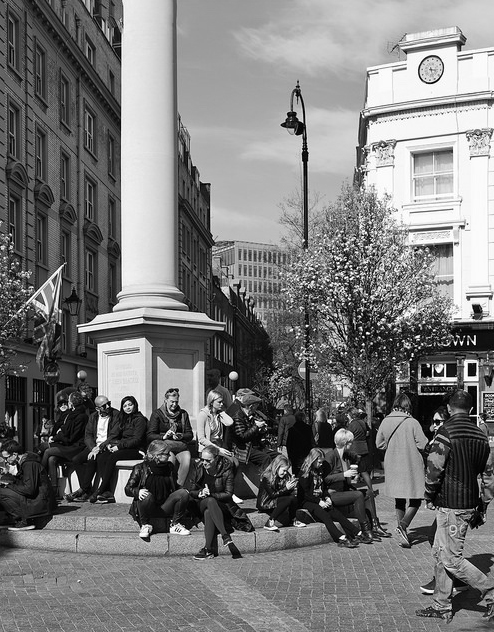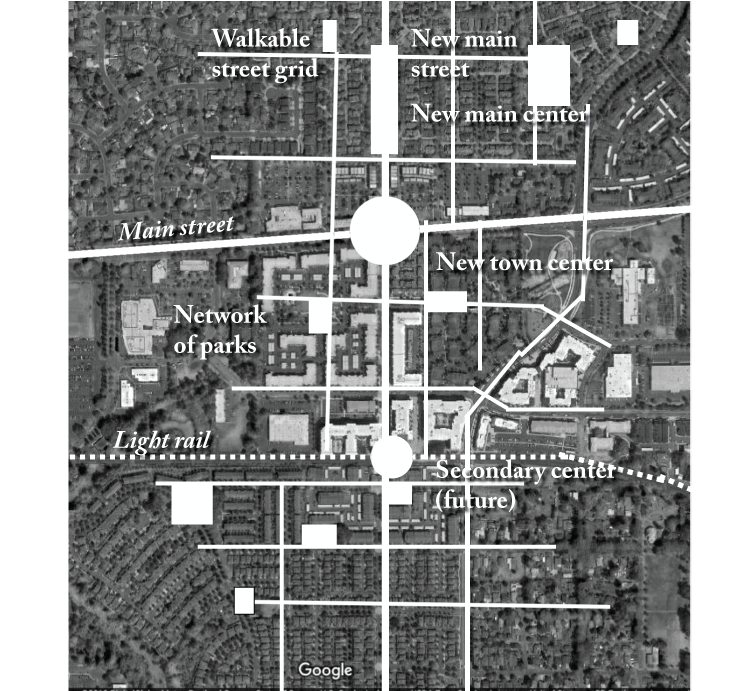…Within the Polycentric Region, establish the distribution and connectivity of public space, following its Blue-Green Network.

__Problem-statement: Public space is the ultimate foundation and connective structure for all human spaces. Cities with inadequate public space systems will fail in critical ways.__
Discussion: Over the last century, cities have seen an alarming decline in the quantity and quality of their public spaces.¹ In part this has occurred because of the increasing prevalence of the automobile, but another major reason is the failure to understand the importance of public spaces — including pedestrian-friendly streets — as integral components of settlement. This problem is becoming more urgent with rapid urbanization around the world in the early 21st Century.
Extensive research has documented the many important benefits of healthy public space systems, including social, economic and ecological benefits.² By contrast, cities that lack well-connected, walkable public spaces, must make up for this weakness with an artificial system of connection — automobiles, private spaces, communication networks and other systems, requiring growing and unsustainable levels of resource consumption.

A network of large, medium and small public spaces, well-connected to each other and within 200m (750 feet) of all homes, in a new development on the Portland OR light rail line.
Today we are gaining a clearer evidence-based understanding of the role of urban space, in comparison to the heady days of post-war planning that privileged the automobile. We see that a healthy city connects a fractal distribution of urban spaces (i.e. a few large ones, more intermediate-size ones, and very many small ones) via a protected set of pedestrian paths (public spaces in their own right) to create a pedestrian web-network. The larger public spaces appear as the ‘beads’ in a complex kind of ‘necklace’. Each larger public space needs specific factors to make it work, however. It must (i) be semi-enclosed by a perimeter of attractive building façades with many entrances; (ii) be ‘fed’ by pedestrians coming from several surrounding blocks of mixed residential and commercial use; (iii) embed a path structure that crosses the plaza and is not cut by sculptures, street furniture, changes of level, or pools of water (these elements should instead be placed strategically so as to define and reinforce the cross-paths); and (iv) have at least one side that is strictly pedestrian.³
For this reason, a public space will usually not work if there is traffic all around it. If the climate permits, one side could have a portico or arcade. Further enhancement could come from the visual interest and ordered complexity in the surrounding façades (no blank concrete or brick faces without entrances, or plate glass curtain-walls).
These design rules are abstracted from successful historic urban spaces. Nevertheless, we need a drastic change in design philosophy (and in economic valuations) to apply them again today, because every signature building has become central in the mind of the contemporary architect. And yet public space needs buildings that help it by creating its border rather than drawing all the attention onto themselves. There is also the question of versatility: public space must accommodate a wide variety of users in different time scales. Those might include a busy person who crosses to get to the other side; someone with time to stroll leisurely; someone with time to sit down and enjoy the space; families with children needing space for their activities; and so on. Designed plazas coming from abstract schemes on the computer screen will invariably fail to cover all of these multiple functions, because each particular activity depends upon multiple factors that are only apparent on the site itself. 4
__Therefore: Lay out every city, and every increment of a city, as a system of inter-connected public spaces, large, medium and small, including streets, squares, parks, and the public areas of buildings. Make these spaces walkable and pedestrian-friendly, with attractive destinations at frequent intervals. Assure that every residence is within 200M of an active public space.__

Assure that the public space system follows the 400M Through Street Network, and extends along its streets, squares and parks. Lay out the system as a series of Paths And Goals, incorporating Activity Pocket and Outdoor Room patterns. Apply Fractal Pattern to design the street furniture and its details, in order to satisfy human scales. Create a Place Network all along its edges, and assure it has Positive Outdoor Space…
notes
¹ UN-Habitat (2016). World Cities Report (p. 5). New York: UN-Habitat.
² See for example citations included in Mehaffy, M. (2018). White Paper on Valuing the Benefits of Public Space Systems (Working Paper). Stockholm: Centre for the Future of Places, KTH Royal Institute of Technology. Available on the Web at http://sustasis.net/PS-Benefits.pdf.
³ See for example Salingaros, N.A. and Pagliardini, P. (2005) Geometry and life of urban space, Chapter in: Back to the Sense of the City, 11th Virtual City & Territory International Monograph Book, Centre of Land Policy and Valuations (Centre de Política de Sól i Valoracions), Barcelona, Spain (2016) pages 13-31.
⁴ This is further discussed in Salingaros, N.A. (2005) Principles of Urban Structure. Techne Press, Amsterdam, Holland.
See more Urban Patterns